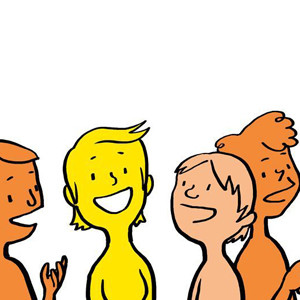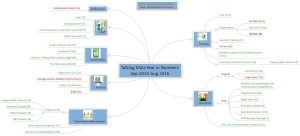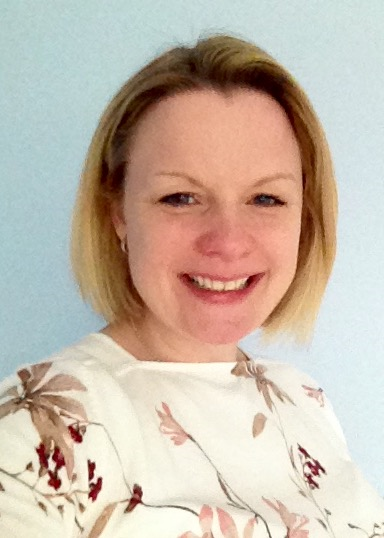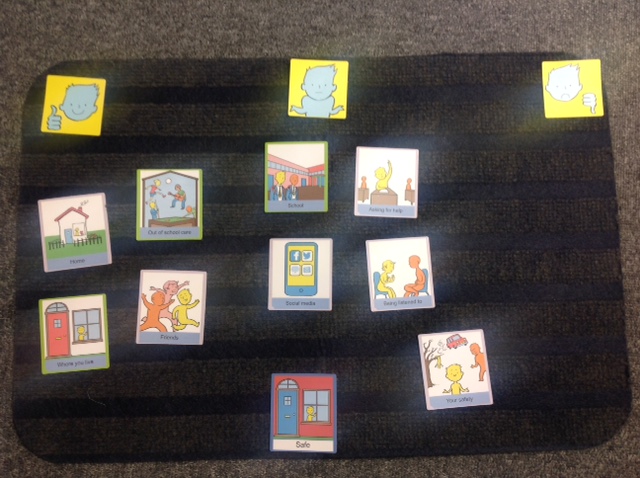We are all looking forward to celebrating Talking Mats is 21 on the 15th August
The morning is aimed at people who are experienced Talking Mats practitioners and will extend thinking and Talking Mats practice. There are an interesting range of parallel sessions to choose from. Each participant will get to choose three topics to attend.
- Talking Mats as a Thinking Tool
- Embedding Talking Mats in Schools
- Talking Mats in Forensic Settings
- Talking Mats in End of Life Care
- My experience of using Talking Mats as a parent
- Talking Mats and Positive behaviour Support
- Talking Mats and Supported Decision- Making
- Empowering people with Learning Disabilities to be Talking Mats Listeners and Trainers
- Talking Mats and Children’s Mental Health
The afternoon is more informal and there will be an opportunity to engage with some of our partners – see how they use Talking Mats and try things out . There will be posters on the use of Talking Mats in lots of different places and for a wide range of applications.
Plus there will be lunch, cake and a few bubbles !
Thanks to funding from NHS Forth Valley endowment committee the event is free but you do need to book your space https://www.eventbrite.co.uk/e/talking-mats-is-21-tickets-62362171935
You can come to the morning only, afternoon only or come for the whole day.
If you can’t come to our event watch out for out blogs and social media celebrating the reach of Talking Mats for 21 days before the 15th of August .Please join in with your contributions using the hashtag #TMis21. For 21 days after our event we will be having a special Birthday offer! Watch this space, more to follow …….
On the 17th April we held a seminar exploring the innovative work being done to support young people with communication needs within justice and mental health settings in both New Zealand and Scotland Read about the morning in our first blog Talking Trouble, New Zealand kindly gave a gift to all delegates of their fantastic Top Tip cards shown in the photo . You can download your own set here
The afternoon session continued the underlying theme that communication support needs are often hidden and many looked after children have support needs that remain unidentified.
Dr Ann Clark from Queen Margaret University presented her research findings looking at Panel members’ and Children’s Reporters’ perspectives on communication in Hearings. Her informative presentation highlighted the need and desire for more training on Speech, Language and Communication Needs. The conclusion was that it is better to assume ALL children who are attending a Hearing have additional support needs, whether or not they have a diagnosis of Speech Language and Communication Needs (SLCN) and Social Work support is also essential in achieving positive outcomes for Looked After Children. SLCN in Hearings April 2018
Our interactive session asked participants to reflect on the information presented during the day and to think about opportunities to improve practice in supporting communication as well as the barriers faced. The main themes that emerged from the barriers were:
- Identifying Speech, Language and Communication Needs in children and young people
- Constraints within Speech and Language therapy services
- Lack of education and training – the word “communication” because practitioners think they know about it when in fact there is a large knowledge gap
- Routes to services can be either Offending or Mental Health pathway
- The balance of power and control in relationships between the practitioner and the person with SLCNs – how committed are we to put genuine inclusive communication approaches in place.
Identify the barriers helps to inform the opportunities and the themes emerging were:
- Some good collaborative practice is happening already and the impact of working together is proven in research – we need to extend this further.
- Joint training sessions – good visual and other communication supports
- SLT have a vital role going forward
- We have a real opportunity at the moment to effect real change in a legislative context with recent Government policy
Kim Harley Kean, Head of the Royal College of Speech and language therapy Scotland office concluded the day and injected a great sense of impetus going forward. She asked 2 key questions:
Q: Is communication support and equality an issue in justice and care services?
Q: Do we want to do something about that?
Having responded with a unanimous YES she helped us to see the potential we have for change. It was obvious from the day that collaboration is vital and the event demonstrated how many different professions and organisations want to do something about the issues. We can be more effective if we do this collectively, even across continents!
The majority of participants felt we should use the event to establish a collaborative network. The key purposes would be to:
- Market – get message out there – tell more people – politicians, government and public – about Speech Language and Communication in Criminal Justice Settings explaining how SLT and Talking Mats have a vital role.
- Share stories, gather evidence.
- Facilitate enriching conversations between practitioners, for example, about aptitudes and approaches needed to negotiate communication behaviour change among professionals as well as people with SLCN…
If you would like to join the network and help to influence change please email info@talkingmats.com with a request to add your name to the youth justice mailing list.
Addressing the communication needs of people in youth justice is key to improving lives. The lack of attention to this is costly. On the 17th of April, we organised a seminar to look at the underlying issues and share good practice.
We were delighted with the collaborative mix of people attending. We had representatives from: the Scottish government, the NHS; Third sector organisations working in youth justice, the police, social workers, professional bodies, universities and social work.
Our thanks to Professor Richard Simpson for chairing the day and setting the tone by emphasising from the start that understanding communication is key to improving service delivery. Following his introduction a series of excellent and stimulating presentations took place creating a fusion of ideas and practice from Scotland and New Zealand.
- Kim Hartley Kean, head of the Royal College of Speech and language therapy Scotland office highlighted the current position in Scotland
- Sally Kedge and Alayne Mckee described the approach adopted by their organisation Talking Trouble in New Zealand.
- Jane Macer the therapeutic service co-ordinator from Starley Hall Fife described an whole system approach to embedding good communication practice within an organisation
- Yvonne McKeown and Sandra Polding Speech and Language Therapists working with young people in a NHS inpatient psychiatric unit in Glasgow shared some case examples.
In different ways the speakers brought up very similar themes:
- Communication can be treated glibly. There is a lack of understanding of what communication difficulties are and of the impact that they have on the lives of young people. These difficulties are often hidden and take time to identify. Lack of identification can have a huge impact on the future lives of young people.
- Finding ways to hear the young person’s voice is key both for the young person but also for organisations in order to deliver appropriate and effective care.
- Recognition of the intergenerational cycle and the importance of getting care and support correct so we break patterns and enable change.
- Providing collaborative solutions and understanding the breadth of communication will help services improve. However, given services often don’t know what they don’t know in terms of the impact of communication difficulties we have to find ways to express those solutions in language that those services can relate to and understand. Listening to organisations and exploring their processes by analysing the communicative demands of each stage can be a helpful way to start.
- Moving forward it is important to knock on open doors i.e. work with people who are receptive to recognising the impact of communication difficulties on young people and their lives but also find the strategic influencers who are sympathetic, in the words of our New Zealand colleagues ‘the aunts and uncles in the field’ who can help to promote the issue and raise awareness at a National level.
- You can’t explore the issue of trauma and adverse childhood experiences without certain precursor, building blocks being in place. This takes time and requires a constancy of approach.
- The importance of inclusive, visual tools becoming common place so that they are not used in isolation and in a vacuum.
- The challenge of supporting and nurturing a young person’s inner voice when they have significant difficulties with language.
- Lack of understanding of communication difficulties may lead to services responding to internalized behaviours that can lead to a fork in life; one way can send the young person down a route of offending behaviour services and the other mental health services.
- The solutions lie in partnership and collaboration between professions and services.
There were lots of creative ways of using Talking Mats that were shared. A couple of examples that stand out were
- Using Talking Mats with social workers to help them unpick what they already know about a young person’s language and communication. This approach helped them think about all the different aspects that contribute to communication and where the young person’s strengths and weaknesses lay e.g. non verbal communication , humour , word finding , understanding complex information, understanding simple information etc .
- Using Talking Mats to support a psychiatric assessment of a young person. One person used his Talking Mat to say he was hearing voices something he was unable to disclose verbally. In this case this enabled an accurate mental state assessment and non-custodial sentence.
I will leave the last word to a young man living in an inpatient unit to support his mental health, his words about communication difficulties are ‘They make you more vulnerable when bad stuff happens’ how true that is and this is why it is important we work together to improve services .
Next steps The community justice network met in the afternoon and were challenged to think about the opportunities and barriers in developing services – read the for blog that covers the afternoon ……… If you missed the seminar and want to join a multiagency network to discuss this and help take this forward in Scotland then please let us know .
Click to read the excellent presentations from the seminar
- CJSCENTalkMatsPresentation170418
- Talking Mats presentation 17 April 2018 Sally Kedge Alayne McKee TTANZ final
- TM seminar 04-18
- Talking Mats & Justice CEN April 2018 Draft
Thanks to Gill Pearl for sending us this information about an international conference for people with aphasia.
Where: Warwick Conference Centre, Coventry, England
When: Sunday 5 and Monday 6 March, 2017
Families, friends, aphasia and stroke organisations, and health professionals are also invited. People with aphasia have planned the conference and will chair the sessions.
The information will be presented in a way that is easier for people with aphasia. There will be support from therapists and students to help people to join in.
The following themes will be discussed
- technology and aphasia, learn and have a go
- increasing awareness of aphasia, and using social media
- sharing what’s happening about aphasia around the world
- research
- support for carers of people with aphasia
- aphasia and the arts.
There will be an exhibition of products relevant for people living with aphasia

- Do something new, develop confidence, be inspired
- Learn from each other and share ideas
- Find out about new services and ways to help
- Meet people with aphasia from around the world!
If you want to find out more, contact Gill or Denise at
- info@buryspeakeasy.org.uk
- gill@buryspeakeasy.org.uk
- 01706 825802 (part time office)
Talking Mat would like to wish you all a Happy Christmas
2106 has certainly been a busy year for us at Talking Mats. We have seen some staff changes saying goodbye to Jill hall and welcoming Morag Crawford. We were delighted when we brought Kirsty onto our staff . Kirsty originally volunteered with us as part of a school transition programme for people with autism. Laura Holmes joined us as a Talking Mats external associate for the North West of England.
If you are interested in what we do and want to see our activity in numbers then have a look at the Talking Mats Year in numbers . Click on image to see the enlarge !
At the moment we are busy preparing for 2017 and we are looking forward to
- The evaluation of our following projects in The New Year
- The National Involvement Network on our partnership with ARC Scotland
- Our programme of service wide training with Central London Community health
2 Continuing to work with
- Patient Opinion
- The Alliance Self-management digital project
- Colleagues in Germany
3 Launching more resources
- Keeping Safe- so far this resource has only been available to people working with people with learning disability in Scotland. We will be holding a specialist seminar about this resource in London on the 17th March so its use can extend south of the border .
- Launching our conversation sets: gardens, holidays, trips out, sports indoor, sports outdoor and football. These were developed as part of the family training for people with dementia but they have much wider use and will be available as additional Talking mats sets
Plus Talking Mat is planning to go to Australia in May!
Nicki and Lois have their flights booked. Agosci here we come ! Then we are over to New Zealand to run foundation training in Christchurch and Auckland before we head back to Melbourne to run the first ever accredited training course in Australia. We will also be running a specialist seminar on Keeping Safe in Melbourne. If you want any details about the trip please get in touch.
We really appreciate all the support we get from everyone involved in Talking Mats and wish you all a happy and peaceful festive season
We are delighted to introduce Laura Holmes our first Regional Talking Mats Associate. She is joining the Talking Mats team and will be working in the North West of England. I will let Laura introduce herself:-
” Hi, I am a Speech and Language Therapist working in Stockport, Cheshire. I am delighted to be joining Talking Mats as the first Regional Associate, covering the North West of England. I work 1 day a week, term-time only for Talking Mats, as well as 3 days a week for the NHS. I am excited about developing awareness, understanding and use of Talking Mats across the area, within the context of the SEND reforms in particular, over the next few months. I feel Talking Mats is a very effective way of truly capturing the voices of the children and young people I work with. The Talking Mats approach also links well with the use of Therapy Outcome Measures, which I am currently trialling with my caseload. I am looking forward to sharing my knowledge and experiences to facilitate wider use of this versatile approach across the North West region.”
It is great to have Laura working with us to build on some of the excellent work being done already in the North West. Two examples of best practice are in Wigan where Talking Mats are used to increase child participation and more recently in Salford. Children’s services in Salford NHS foundation trust are committed to seeking the views of children and young people about how they feel about their health appointments. They have finished piloting their own Talking Mats set and the revised set has just been sent to the printers – it looks great.
We are running a training course in Liverpool on the 21st April and we would love to meet more of you from the North West.
This post is about the importance of the Talking Mats blog and how it can be used as a rich resource of information for anyone interested in communication. One of the first ‘tasks’ that I was asked to do after starting my new job at Talking Mats was to create and give a presentation to an international audience of trainees at our most recent course for Accredited Trainers. I had only been in post for 2 weeks and I was also a trainee on the course, so the pressure was on!
The main aims of the presentation was to promote the Talking Mats Blog as a source of rich information which is accessible to anyone, that Accredited Trainers can use it in their own training courses, and also to encourage Accredited Trainers to write their own blog posts to describe how they use Talking Mats in their working and personal lives.
I wanted to try and make the presentation look a bit more dynamic than the usual ‘death by PowerPoint’ that can sometimes occur after a whole day of looking at slides! I decided to use Prezi, “a cloud-based presentation software and storytelling tool for presenting ideas on a virtual canvas”, as I’d had good feedback about it when I had used it in the past and thought this would be a perfect opportunity to roll it out again. You can see the completed presentation here.
When the day came to give the presentation, I wasn’t feeling on top form after having flu for a few days previously. Because of this my memories of it are rather hazy (which isn’t good for the purposes of writing a blog about the presentation!) but from what I’ve heard, apart from looking ill, I managed to get my points across without confusing (or frightening) the audience!
It was a fantastic opportunity to take part in the Accredited Training course and to hear the stories of all the trainees who are dedicated to using Talking Mats to improve the lives of the people they help on a daily basis.
I’ve also just found out that the team at Talking Mats have been blogging for 4 years, so get reading!
We are delighted to be a Winner in the People Driven Digital Health Awards which were held in Leeds on Friday 3rd July. These awards were instigated to recognise the work of digital health innovators from across the UK and aim to connect the people who have ideas and make them happen.
The event was organised by mHabitat and compered by a well known health commentator, Roy Lilley, of the Academy of Fabulous Stuff. The evening was full of fun and energy and we met lots of interesting people and made good connections. There is loads going on in digital health and services should make use of all these fabulous innovations that will improve people’s lives and health services. To get a flavour of the evening follow #PDDAwards15 and to find out about the other winners click here.
Our category, ‘the most impressive third sector digitally enabled service’ recognises third sector services which have embedded digital tools and services into improving people’s experience and outcomes. We very honoured to win this category with our digital Talking Mat. The announcement of the winners was followed by a flurry on Twitter which you can dip into here .
The intention at the core of the Scottish Strategy Getting it Right For Every Child (GIRFEC) is to keep the child at the heart of the planning process. Helping the child to set personal outcomes based on what is important to them, should be the starting point. In practice, this can be difficult as many of the well-being indicators are difficult for children and parents to grasp. A primary headteacher highlighted the limitations, explaining that she was trying to find out about how safe one of her pupils felt. When the pupil asked her to explain what she meant, she replied “Well, do you feel safe in my office or do you think one of the books might fall off the shelf onto your head?”
The Consulting Children and young people resource allows you to reorganise the symbol sets to reflect on each of the specific well being Indicators. If we take the example of safety, we can make the concept more accessible to the child by providing concrete examples. This may include: asking for help if needed, feeling listened to, as well as, safety in specific settings for example at home; in school; with friends or using social media. The CCYP resource helps the interviewer to think about the child’s age and stage of development and uses examples that are meaningful.
The visual framework means that their is a clear record of the shared understanding between the child and the interviewer of the concept of safety.
We are planning to run specialist sessions on using Talking Mats with the SHANARRI indicators in order to ensure that the child’s view is at the heart of the planning process. If you are interested please let us know what would work best for you.
Email us at info@talking mats and tell us if you would prefer a Saturday session, a Twilight session or a half day session and state your preference for morning or afternoon.
Speech presented at the launch of new Talking Mats Resources
Hello everyone, my name is Greig McMurchie and I would like to take the opportunity to welcome you all here today. If I look familiar it may be because you recognised me from the original talking mat video, where I had a cameo appearance with the lovely Joan murphy of course that was over ten years ago, and back then I was much younger and better looking. Joan however is still as lovely as the day I met her.
As you can see, I have been involve in talking mats for many years now, ever since Joan asked me to help her trial a new communication system, that she and her colleague Lois had been developing. My initial thoughts were wow, this sounds really complicated and I was a little bit scared. But I had known Joan since I was little and I really wanted to see what this new Communication system was all about.
When Joan came to visit me at that Dundas day center, all those years ago, all my fear quickly disappeared, it was really easy. I was able to have my say, and because it was visual I could change my mind also. I began using talking mats to share my views, opinions and wishes, and before long this system was helping me to make life Changing decisions, such as what I wanted to do with my life once I had finished my college course. In fact you could argue that I am where I am today because of talking mats. And I like to say I wouldn’t have it any other way.
Anyway, that was away back then, and times have move on. About four weeks ago Joan and Lois came to Upper Sprinlands to visit me, and of course show me their wonderful bran new talking mats app. My initial thoughts were this sound fantastic, and when they arrived we had a wee chart and they explained what they had been doing.
I don’t know about everyone else, but when I was a kid a tablet was something you took if you were not feeling too well, an android was a character from a computer game and an apple was something you gave to your teacher to butter them up if you forgot to do your homework. But today all this modern technology is making it easy for everyone to engage creating doorways to all kinds of wonderful stuff. And boy can I say this new talking mats app is all kinds of wonderful.
So after we chatted I got to have a wee play with the new app, I couldn’t believe how easy it was, you were able to just move the pictures around and place them were you want them on the screen. The New picture sets are fantastic, they are bright colourful and easy to understand. I also like the way you can enlarge the picture to make it easier to see. And of course the fact that it come already to use. You can even take a photograph and send it to yourself by email. No more printing, cutting out and Velcroing, no more hunting for the camera only to realize the batteries are flat and you can’t use it anyway. Everything is just nicely packaged. And the fact that it can be used not only on an Ipad but also on a computer makes it even more accessible.
Dare I say I personally felt the new App for me was even easier than the old system; it is quicker, fun and very cool? Now I just need to persuade Upper springland to Purchase a copy or twelve.
Thank you talking Mats
(Speech at the Launch of the New Talking Mats Resources )
 Online training login
Online training login 








